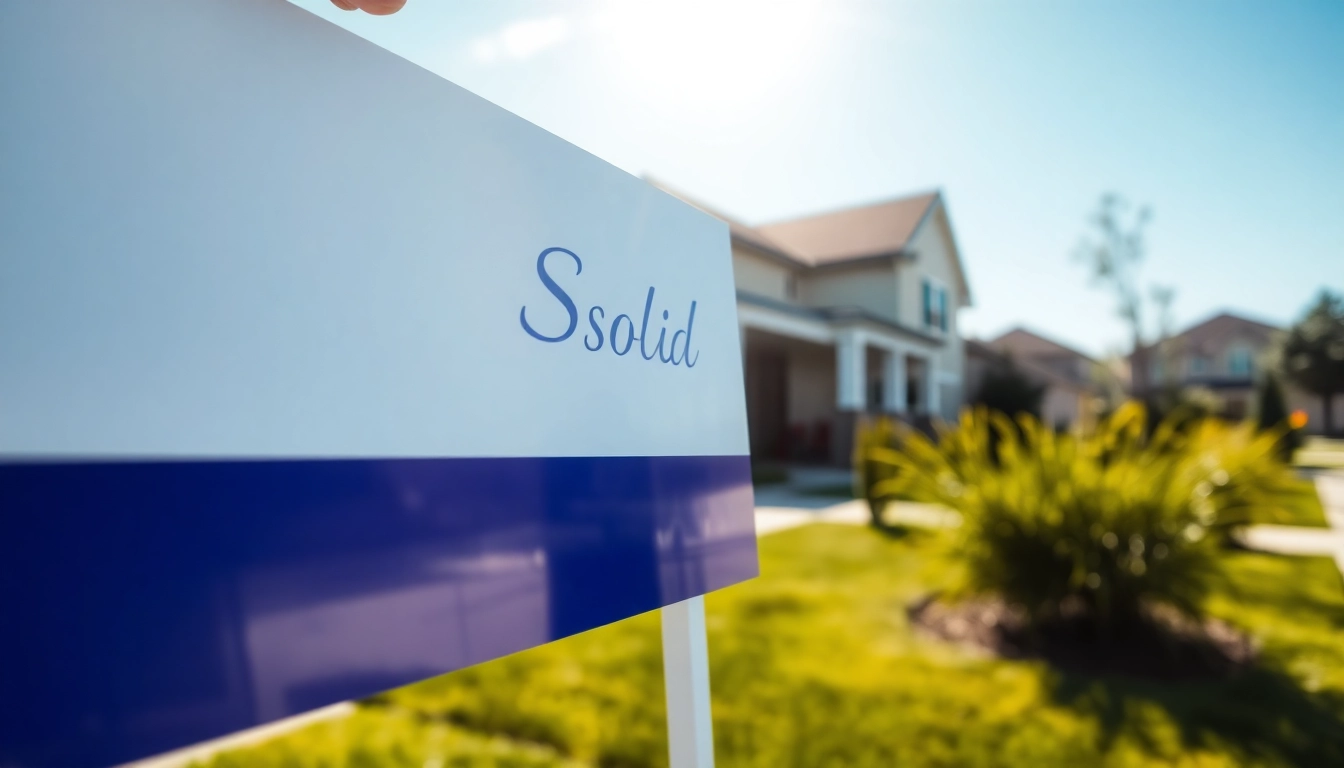Understanding the Importance of Sold Signs in Real Estate Marketing
In the fast-paced world of real estate, visual cues play a vital role in attracting potential buyers and establishing credibility for agents and agencies. Among these cues, sold sign stands out as a quintessential tool for signaling successful transactions and generating interest in listings. These signs do more than merely indicate that a property has been sold; they serve as an active marketing component that can influence future prospects and reinforce the reputation of an agent or agency.
Real estate professionals have long recognized the power of physical signage in drawing attention. A well-designed sold sign captures the eye of passersby, communicates professionalism, and helps in creating a perception of high demand. This visual reminder encourages potential clients to think of the agent’s expertise, thus positioning the agent as a successful and trustworthy partner in property transactions.
In line with this, understanding the role of sold signs encompasses examining how they attract buyers, impact listing visibility, and uphold legal and ethical standards. Each of these facets is critical in crafting an effective signage strategy that amplifies an agent’s brand, accelerates sales, and maintains compliance with industry regulations.
Role of Sold Signs in Attracting Buyers
Visual signals are among the earliest interactions potential buyers have with a property. An eye-catching sold sign, strategically placed and visually appealing, immediately communicates that a property has recently changed hands, thereby sparking curiosity among other buyers. The psychological effect of seeing a “sold” sign can trigger a sense of urgency, making viewers more eager to act quickly on similar listings.
Furthermore, sold signs serve as social proof. They implicitly suggest that the property in question is desirable, which can influence other potential buyers’ perceptions about market activity and demand. This effect is especially potent in neighborhoods experiencing high turnover or a seller’s market, where visible success stories can motivate prospective buyers to consider listing their own properties or seeking similar opportunities.
Studies in marketing psychology indicate that people are inclined toward options that others have already chosen, a concept known as social proof. When individuals see numerous sold signs on properties within their preferred area, they tend to associate these areas with activity and desirability, thus increasing the likelihood of inbound inquiries and future sales success.
Impact on Listing Visibility and Reputation
Beyond individual sales, sold signs help build the reputation of real estate agents and brokerage firms. Consistent use of professional, well-designed sold signage project image and competence, encouraging sellers to choose the same agent when listing new properties. This visibility creates a domino effect—agents seen consistently closing deals gain recognition and trust in the community.
In addition, when a property is marked as sold via a prominent sign, it signals to neighbors, community members, and potential clients that the agent is active and successful in the local market. Such reputation-building through visual marketing contributes to a positive cycle, leading to more listings and accelerated sales timelines.
Moreover, strategic placement of sold signs at prime locations—such as main roads or block entrances—maximizes exposure. This targeted visibility ensures that more prospective clients become aware of the agent’s success and the vibrant activity within their target area, reinforcing the agent’s position as an industry leader.
Legal and Ethical Considerations When Using Sold Signs
Effective use of sold signs must adhere to local regulations and ethical standards. Many jurisdictions impose rules regarding signage placement, size, and timing to prevent obstruction, distraction, or neighborhood clutter. Failure to comply can result in fines or legal disputes, undermining the agent’s credibility and operational efficiency.
Common legal considerations include obtaining necessary permits before installing signs, ensuring that signage does not block visibility for drivers or pedestrians, and adhering to size restrictions. Additionally, some areas have rules about the timing of signage—such as not placing signs prematurely or removing them promptly after the sale is complete.
Ethically, transparency is paramount. Any claims made on the sign, such as “Sold by [Agent Name],” should be accurate. Misleading signage can lead to legal repercussions and damage reputation. Skilled agents also ensure that signage doesn’t infringe on neighboring properties or create safety hazards, adhering to local ordinances and industry best practices.
Design Elements of High-Quality Sold Signs
Choosing the Right Colors and Fonts for Visibility
Design is a crucial component of signage effectiveness. Exceptional sold signs utilize bold, contrasting colors to capture attention quickly. Bright reds, blues, and yellows are popular choices because they stand out against various backgrounds. The font should be large, legible, and straightforward—sans-serif typefaces like Helvetica or Arial are standard because they are easy to read from a distance.
Consistency in color schemes and fonts across multiple signs enhances brand recognition, making it easier for potential clients to associate the signage with a particular agent or company. Additionally, using colors that evoke trust and professionalism, such as blue or green, can positively influence perceptions of reliability and stability.
Including Essential Information: Logo, Contact, and Property Details
While the primary purpose of a sold sign is to convey success, it also serves as a mini marketing tool. A clear display of the agent’s logo or company branding increases recognition, while prominently featuring contact information—such as a phone number or website—facilitates direct inquiries. Including property-specific details, like the address or a distinctive tagline, can reinforce the message and generate direct interest.
Designing signs with a balanced layout ensures that critical information is noticeable but not cluttered. Incorporate whitespace thoughtfully to improve readability and visual appeal.
Customization Tips to Reflect Brand Identity and Property Uniqueness
Customizing sold signs to reflect a brand’s identity helps differentiate an agent in a competitive market. Incorporate logos, specific color palettes, and unique slogans that resonate with target audiences.
For properties with distinctive features, such as historic charm or modern architecture, consider tailored signage styles that complement the property’s character. This personalized approach can make the signage more memorable and convey a sense of professionalism and attention to detail.
Employing professional graphic design services or utilizing customizable templates from reputable signage providers ensures that branding is consistent and visually compelling.
Material and Durability for Long-lasting Sold Signs
Optimal Materials for Outdoor Exposure
The durability of a sold sign depends heavily on its material. Common high-quality outdoor sign materials include corrugated plastic (coroplast), aluminum, and weatherproof vinyl. Coroplast signs are lightweight, affordable, and resistant to moisture, making them ideal for temporary or semi-permanent signage.
Aluminum signs are more durable and resistant to rust, suitable for long-term placement in high-traffic areas. Vinyl banners or stickers are versatile, easily customizable, and resistant to fading and tearing when laminated appropriately.
Weather Resistance and Lifespan Considerations
Signs exposed to varying weather conditions—rain, wind, sun, snow—must be designed for weather resistance. Laminated printing, UV-resistant inks, and sturdy mounting hardware extend the lifespan of sold signs and maintain their visual appeal.
Proper installation, such as using durable stakes or brackets, ensures stability, while regular maintenance—like cleaning and color touch-ups—keeps signs looking professional throughout their service life.
Eco-Friendly and Sustainable Options in Sign Production
With growing environmental awareness, choosing eco-friendly materials and production processes is increasingly important. Recyclable plastics, sustainably sourced wood, and biodegradable inks are options that minimize ecological impact.
Companies specializing in eco-conscious signage utilize recyclable materials, low-VOC inks, and renewable energy during production, aligning branding efforts with sustainability values sought by modern consumers.
Placement Strategies to Maximize Sign Effectiveness
Strategic Locations for Visibility from the Street
The placement of sold signs is critical to ensure maximum visibility. Ideal locations include high-traffic intersections, near driveways, or along main roads where they can be seen by the broadest audience. Elevating signs using stands or mounting on poles can improve visibility, especially in crowded neighborhoods or obstructed areas.
Additionally, signs placed within sightlines of neighboring properties can attract nearby potential clients who may be considering buying or selling.
Timing for Installing and Removing Sold Signs
Installing signs promptly after closing ensures the property’s sale is clearly communicated in real-time, leveraging recent success to generate interest. Removal should be swift once the deal is finalized to prevent confusion or outdated signage. Some agents opt for temporary signs with removable features or digital overlays to streamline this process.
Utilizing Additional Signage and Digital Overlays
Augmenting physical signage with digital tactics enhances visibility. QR codes, for example, can direct viewers to detailed property listings or agent websites. Additionally, digital overlays or portable LED signs can highlight recent sales and achievements dynamically.
In areas with high foot or vehicle traffic, combining physical signs with online marketing campaigns reinforces the messaging and broadens reach, increasing overall impact.
Advanced Tips for Selling Properties with Sold Signs
Leveraging Sold Signs in Social Media and Online Marketing
Smart real estate marketing integrates physical signage with digital platforms. Sharing images of sold signs on social media, coupled with success stories and client testimonials, amplifies credibility. Marketers can create post-clips or virtual tours that showcase the property in tandem with the sold sign to reinforce brand visibility.
Embedding QR codes on signs that link to virtual tours or agent profiles enables immediate online engagement, bridging offline and online channels effectively.
Incorporating Testimonials and Success Stories
Adding brief testimonials or brief success narratives alongside signage or in associated online posts can boost influence. Examples include highlighting how an agent facilitated a quick sale or secured a favorable price, making the “sold” status more compelling and trustworthy.
Measuring ROI and Optimizing Sign Strategy Over Time
Evaluation metrics such as inquiry rates, listing conversions, and online engagement provide insights into signage effectiveness. Tracking changes in sales timelines and community feedback helps refine placement, design, and timing strategies.
Regular audits and A/B testing of sign designs, locations, and messaging ensure continuous improvement, ultimately maximizing return on investment and lead generation.













